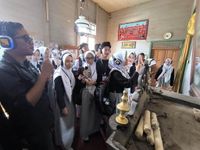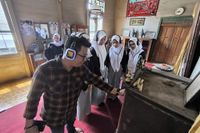PARINGIN – On Tuesday, April 22, 2025, 54 students from SMAN 1 Paringin participated in the Jelajah Cagar Budaya program in Balangan Regency, an initiative organized by the Education and Culture Department (Disdikbud) of Kalimantan Selatan. This program aims to promote, preserve, and strengthen the younger generation's understanding of local history and cultural identity.
The event took place at two cultural heritage sites, providing students not only with a chance to see historical relics up close but also to engage in educational sessions led by experts. Arry Risfansyah, the Head of the Cultural Heritage and Museum Section of Disdikbud Kalsel, emphasized that the program is designed specifically for young people. "Through this activity, we spread knowledge about cultural heritage to the youth, allowing them to better understand and appreciate the values of struggle embedded in these sites," he stated.
Risansyah also highlighted the importance of helping students connect the past with the present while fostering a sense of responsibility to preserve their cultural heritage. "Preserving and protecting cultural heritage is a form of respect for the historical values and struggles passed down by our ancestors. It is crucial to instill this awareness from an early age," he added.
To enrich the learning experience, Disdikbud collaborated with the Cultural Heritage Expert Team (TACB) from the Archaeological Office and the Regional Cultural Preservation Office of South and Central Kalimantan. The presence of these experts provided a deeper and more scientific perspective on the materials presented. One of the speakers, Mansyur, a lecturer in History Education at FKIP Universitas Lambung Mangkurat, explained the significance of the two cultural sites visited by the students, namely the Jembatan Besi Lampihong and Rumah H. Sjoekoer.
Mansyur described Jembatan Besi Lampihong as a historical relic from the Dutch colonial era, connecting the villages of Hilir Pasar and Simpang Tiga. Built around the 1930s, this bridge is not just a structure but a symbol of the infrastructure advancements during colonial times. "This bridge was constructed using steel and concrete imported from Europe, combined with the local Ulin wood, showcasing the technological prowess of that era," he noted.
Meanwhile, Rumah H. Sjoekoer stands as a testament to the rubber boom in Balangan. Its distinctive architecture and historical significance reveal the life of the community during the colonial economic influence. Mansyur pointed out that this house encapsulates the social dynamics of the time, making it essential for students to learn about such historical contexts.
The Jelajah Cagar Budaya program is part of a broader, long-term commitment by Disdikbud Kalsel to reach all regencies and cities in the region. Similar activities have also been organized this year in Hulu Sungai Tengah, Tanah Bumbu, and Tanah Laut, demonstrating a concerted effort to engage students across Kalimantan Selatan in cultural education.
Kurniawan, a history teacher at SMAN 1 Paringin who accompanied the students, praised the initiative as a contextual and engaging learning method. "Students become more active and interested because they can directly observe historical artifacts. This approach makes it easier for them to grasp the subject matter," he remarked.
The enthusiasm displayed by the students signals a positive trend, indicating that the younger generation still holds an interest in history and culture—provided it is presented through experiential learning methods. As Kurniawan noted, such engagements can help ensure that cultural heritage is not only preserved but also cherished by future generations.
Ultimately, the Jelajah Cagar Budaya program serves as a vital bridge connecting young people with their cultural roots, fostering a sense of identity and pride in their heritage. By learning about the past, students are better equipped to navigate the complexities of the present and future, understanding the importance of their cultural legacy.
As the program continues to expand its reach and impact, it stands as a testament to the commitment of educational authorities to cultivate a well-informed and culturally aware generation that values its history and heritage.





